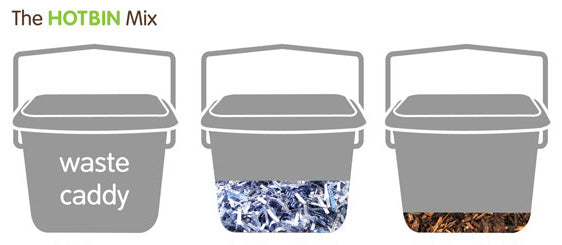Woodchip and paper are essential parts of the Composting process. Woodchip (or woody matter excluding sawdust and wood shavings) provide a supportive structure that promotes the flow of oxygen to bacteria inside the unit and keeps the HOTBIN composting aerobically.
Shredded paper (or cardboard) controls moisture levels inside the unit absorbing excess water that is not evaporated during the hot composting process helping to prevent a wet soggy heap.
How Much Woodchip and Paper Should I Add?
Whatever sized container you are using to collect your waste, here is an easy way to understand the ratios and required measurements of woodchip and shredded paper to add in addition your waste.
 |
||
|
Empty in a full |
Add in ½ caddy of |
Add in ⅕ of a caddy of bulking agent |
How Should I Add Woodchip and Paper to the HOTBIN?
- Add your full caddy of waste to the HOTBIN
- Fill the same caddy half way with dry shredded paper /or cardboard (do not pre-soak) and then add to the HOTBIN
- Fill the caddy a fifth of the way with woodchip and then add
- Using the rake give the very top layer of the heap a quick stir (just what you have added), this will evenly incorporate the different materials and encourage composting bacteria into the fresh waste.
- You do have the option of pre-mixing your kitchen waste, woodchip and paper in a bucket if you prefer before adding to the HOTBIN.
- Once waste is added and mixed - Close the lid – all done!
Tips:
- Discover more about woodchip here: All About Woodchip
- The contents of every HOTBIN will vary – our ratios are a guideline. Remember the wetter your waste, the more shredded card or paper you will need to absorb the excess moisture, grass is an excellent example of this and why we only recommend address dry grass to the heap.
- Remember to keep an eye on your HOTBIN and if in doubt add a bit more shredded paper and bulking agent to ensure good moisture control and airflow. It is much easier to fix a dry bin, than a wet one!




